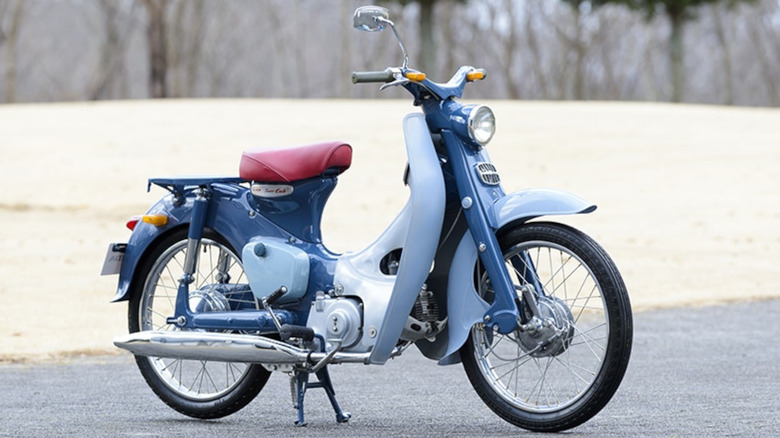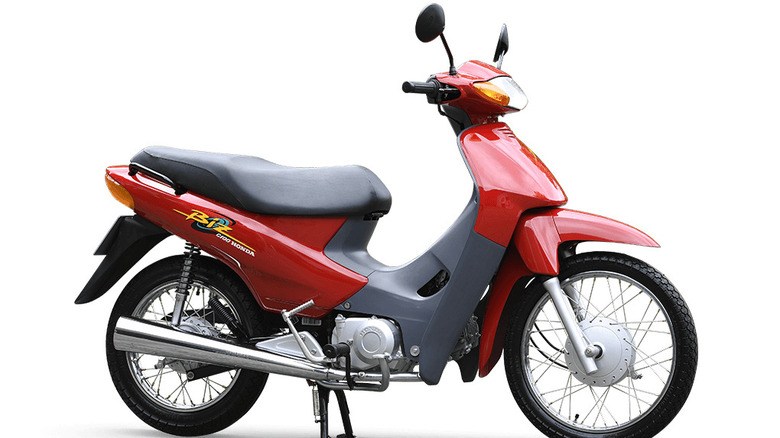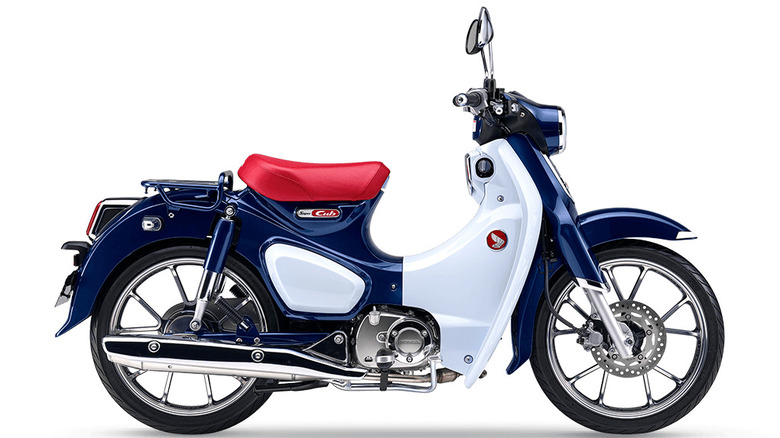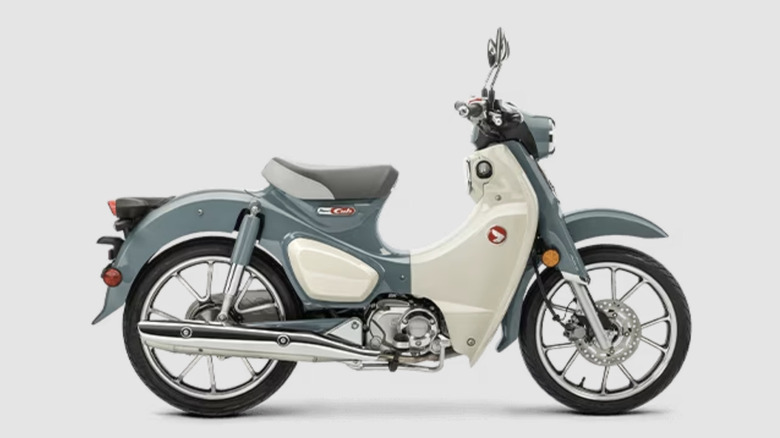Everything To Know About Honda's Super Cub Motorcycle
Since Soichiro Honda founded the company that carries his name in 1948, Honda has cranked out reliable econoboxes like the Accord and Civic, and spawned the luxury auto brand, Acura. Honda made several memorable cars that never made it to United States dealerships, but for every car sold worldwide in the last dozen years or so, Honda has sold more than three times as many motorcycles. Honda's first two-wheeler was the 1949 Dream D, which had a two-stroke 98cc motor. Soichiro Honda wasn't happy with the auditory or environmental pollution produced by his two-stroke engines, so his next motorcycle, the 1953 Dream E, had a four-stroke engine.
Five years later came the Super Cub C100, which had a four-stroke 49cc (3 cu-in) engine and three-speed semi-automatic transmission. That first Super Cub could carry 3 liters of gas (a little more than 3/4 of a gallon), and reach a top speed of 43 mph. The light, zippy, Super Cub existed in the netherworld between mopeds and motorcycles, and helped pave the way for later, larger Honda creations like the CB 750 — the bike that ChatGPT considers the best motorcycle ever made.
Honda introduced two new versions of the Super Cub in its first 10 years
The Super Cub was given a step-through design to make it easy to mount, and was engineered to be simple to operate, as well as agile enough to navigate the crowded streets of developing countries. By the time the CB750 made its debut in 1969, the Super Cub had been updated twice. In 1962, Honda brought the two-seater CA100 to market, and in 1966, Honda introduced the C50, which had a new overhead cam engine and a more scooter-like appearance.
In 1981, the CT110, a trail-oriented version of the Super Cub, was created. This model had the largest and most potent Super Cub engine to date, a 105cc single-cylinder that cranked out 7.5 horsepower. A Super Custom version of the Super Cub 50 hit the roads in 1983, with an astounding fuel economy of 180 km/l (more than 420 mpg).
The 1991 Super Cub 50 Standard brought some cosmetic changes and the addition of an analog fuel gauge. In 1998, Honda built the C100 BIZ for Brazilian markets. This Super Cub had a larger fairing and a smaller rear wheel to make room for more storage space under the seat.
The 21st Century brought larger engines
Japan got the Super Cub 110 in 2009, which had newly designed exhaust pipes and a two-stage clutch to smooth out rough shifts.
In 2017, Honda celebrated the production of the 100 millionth Super Cub at its plant in Kumamoto. At the ceremony, Honda President Takahiro Hachigo pledged to keep the Super Cub alive until production reaches the 200 million mark.
The milestone of 100 million units sold makes the Super Cub the best-selling motor vehicle in history, according to Motorcycle.com. An all-new C125 model followed in 2018. This was the most powerful and well-appointed Super Cub to date, with a 9.2 horsepower 125cc SOHC engine, four-speed transmission, dual rear shocks, and anti-lock disc brakes in front.
The lighting system was upgraded with LED bulbs, and the smart key ignition system from the Gold Wing was carried over to the Super Cub line, beginning with the C125. It also got digital instrumentation, including a speedometer, tachometer, fuel gauge, and clock. The front suspension was integrated with the fairing for a smoother look.
A new 2024 Super Cub costs less than $4,000
2021 saw the debut of the CT 125 Hunter Cub. This single-seater had a rugged suspension suitable for off-road riding and a 124cc engine that put out 8.7 horsepower and 8.1 pound-feet of torque. The CT 125 was sold as the Trail 125 in the United States and boasted a ground clearance of 6.5 inches. An updated Super Cub 110 came in 2022, and had anti-lock brakes and tubeless tires on both wheels.
The 2024 Super Cub C125 is powered by the same 124cc engine that drove the previous 125 numbered models, and carries over the digital instruments that were introduced in 2018. It also has a hydraulic front disc brake with ABS and a four-speed semi-automatic transmission. The newest Super Cub 125 has a base price of $3,899, and the only factory add-on available is a rear cargo carrier, which adds $85.92 to the price. Without the cargo rack and filled with fuel, oil, and coolant, the 2024 Super Cub 125 weighs just 238 pounds, making it easy to load onto a trailer or truck.
Vintage Super Cubs can be priced from the low $2,000s to $6,000 or more, but bargains can be found for below $1,500 if you're lucky.



